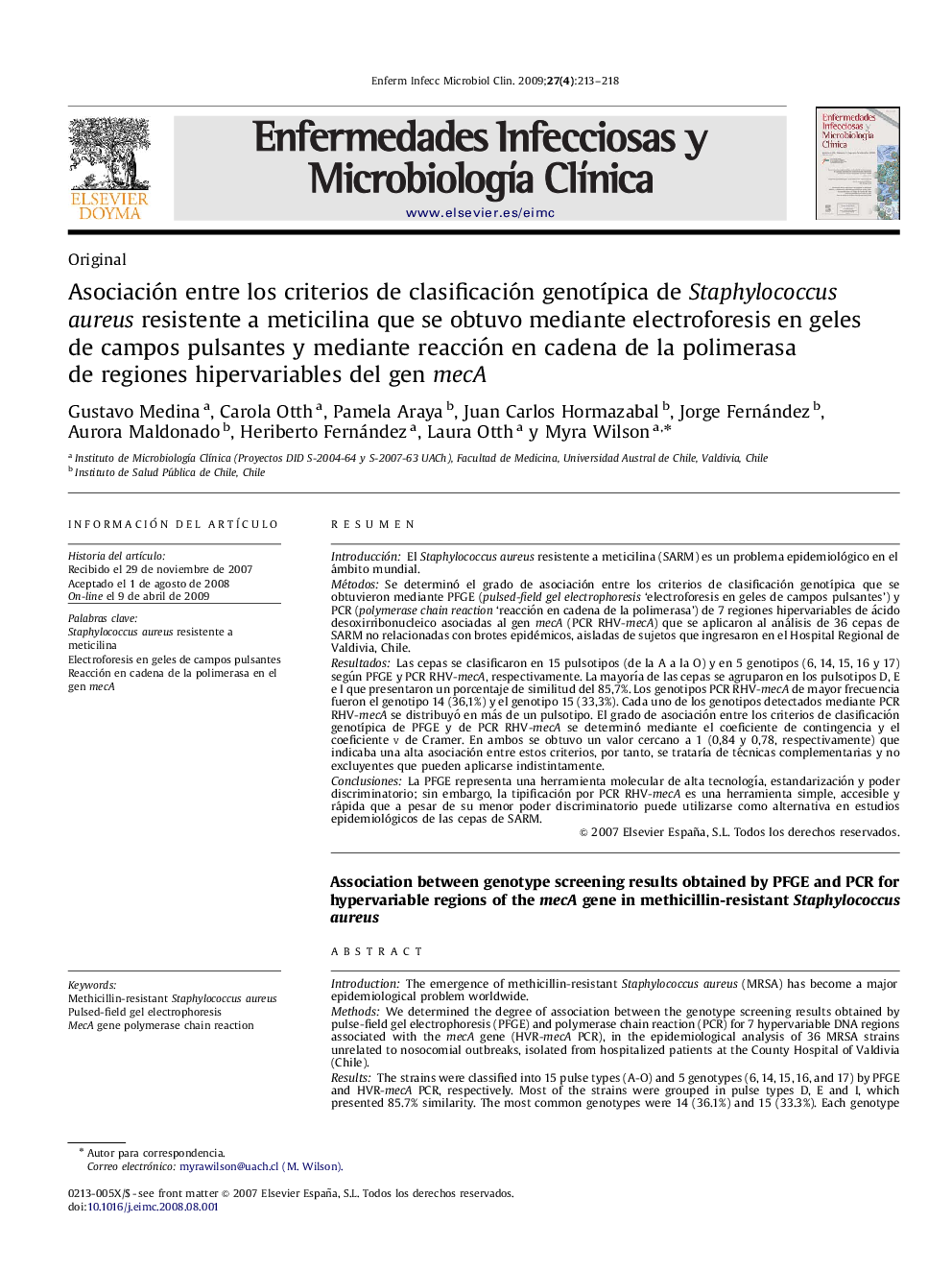| کد مقاله | کد نشریه | سال انتشار | مقاله انگلیسی | نسخه تمام متن |
|---|---|---|---|---|
| 3402457 | 1222719 | 2009 | 6 صفحه PDF | دانلود رایگان |

ResumenIntroducciónEl Staphylococcus aureus resistente a meticilina (SARM) es un problema epidemiológico en el ámbito mundial.MétodosSe determinó el grado de asociación entre los criterios de clasificación genotípica que se obtuvieron mediante PFGE (pulsed-field gel electrophoresis ‘electroforesis en geles de campos pulsantes’) y PCR (polymerase chain reaction ‘reacción en cadena de la polimerasa’) de 7 regiones hipervariables de ácido desoxirribonucleico asociadas al gen mecA (PCR RHV-mecA) que se aplicaron al análisis de 36 cepas de SARM no relacionadas con brotes epidémicos, aisladas de sujetos que ingresaron en el Hospital Regional de Valdivia, Chile.ResultadosLas cepas se clasificaron en 15 pulsotipos (de la A a la O) y en 5 genotipos (6, 14, 15, 16 y 17) según PFGE y PCR RHV-mecA, respectivamente. La mayoría de las cepas se agruparon en los pulsotipos D, E e I que presentaron un porcentaje de similitud del 85,7%. Los genotipos PCR RHV-mecA de mayor frecuencia fueron el genotipo 14 (36,1%) y el genotipo 15 (33,3%). Cada uno de los genotipos detectados mediante PCR RHV-mecA se distribuyó en más de un pulsotipo. El grado de asociación entre los criterios de clasificación genotípica de PFGE y de PCR RHV-mecA se determinó mediante el coeficiente de contingencia y el coeficiente v de Cramer. En ambos se obtuvo un valor cercano a 1 (0,84 y 0,78, respectivamente) que indicaba una alta asociación entre estos criterios, por tanto, se trataría de técnicas complementarias y no excluyentes que pueden aplicarse indistintamente.ConclusionesLa PFGE representa una herramienta molecular de alta tecnología, estandarización y poder discriminatorio; sin embargo, la tipificación por PCR RHV-mecA es una herramienta simple, accesible y rápida que a pesar de su menor poder discriminatorio puede utilizarse como alternativa en estudios epidemiológicos de las cepas de SARM.
IntroductionThe emergence of methicillin-resistant Staphylococcus aureus (MRSA) has become a major epidemiological problem worldwide.MethodsWe determined the degree of association between the genotype screening results obtained by pulse-field gel electrophoresis (PFGE) and polymerase chain reaction (PCR) for 7 hypervariable DNA regions associated with the mecA gene (HVR-mecA PCR), in the epidemiological analysis of 36 MRSA strains unrelated to nosocomial outbreaks, isolated from hospitalized patients at the County Hospital of Valdivia (Chile).ResultsThe strains were classified into 15 pulse types (A-O) and 5 genotypes (6, 14, 15, 16, and 17) by PFGE and HVR-mecA PCR, respectively. Most of the strains were grouped in pulse types D, E and I, which presented 85.7% similarity. The most common genotypes were 14 (36.1%) and 15 (33.3%). Each genotype detected by HVR-mecA PCR was distributed in more than one pulse type. The degree of association between genotypic screening by PFGE or HVR-mecA PCR was determined by calculating Cramer's V statistic and the contingency coefficient. In both cases, a value near 1 (0.84 and 0.78, respectively) was obtained, indicating a high association between these genotypic screenings. Thus these are complementary, not exclusionary techniques that can be equally applied.ConclusionsPFGE is a standardized, high-technology molecular tool with considerable discriminatory power. HVR-mecA PCR is a fast, simple, accessible tool that has lower discriminatory power; nonetheless it can serve as an alternative method for epidemiological research in MRSA strains.
Journal: Enfermedades Infecciosas y Microbiología Clínica - Volume 27, Issue 4, April 2009, Pages 213–218